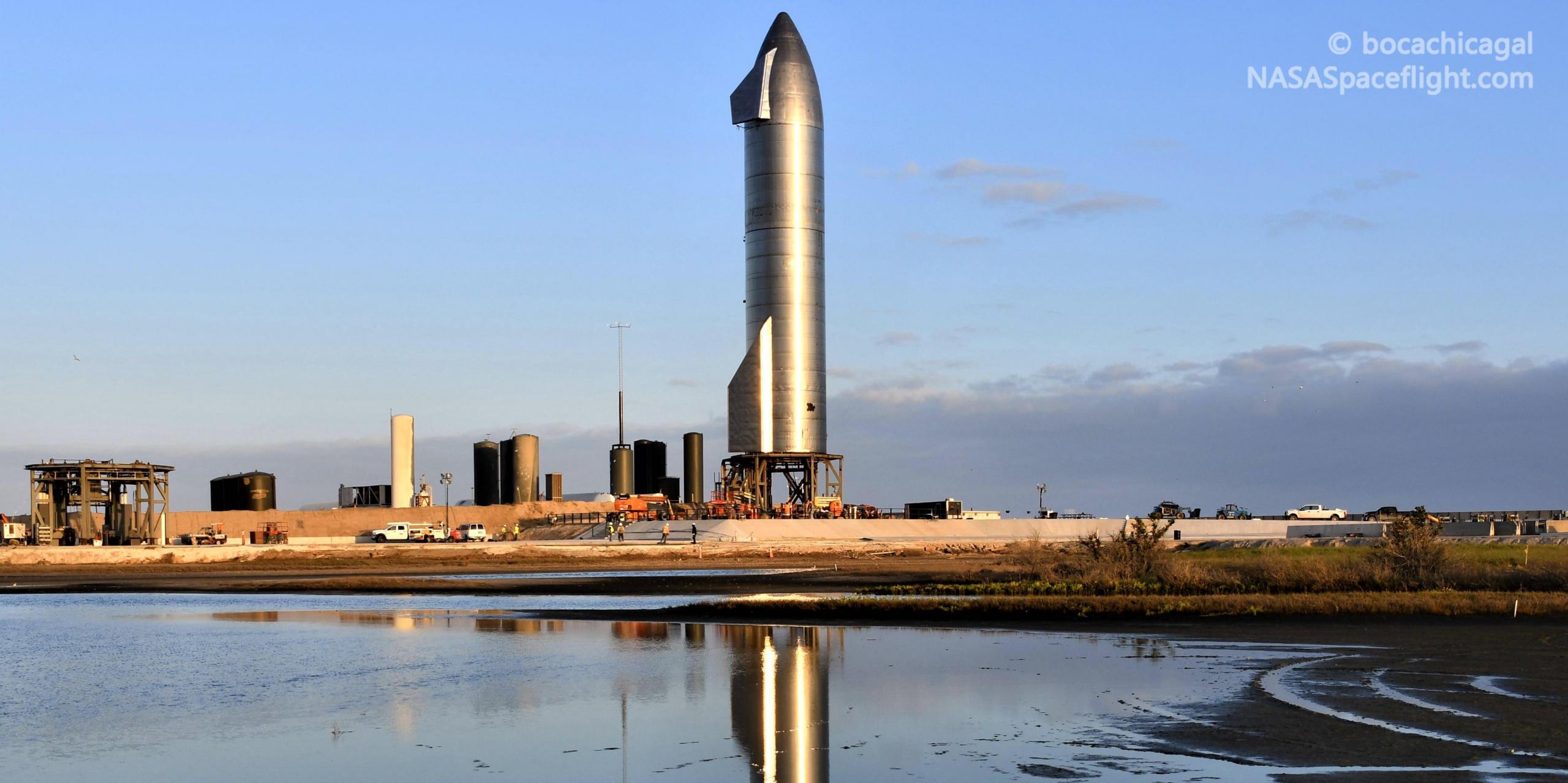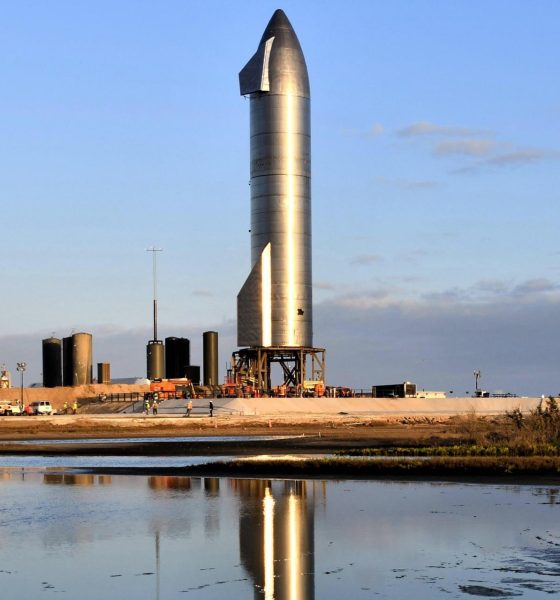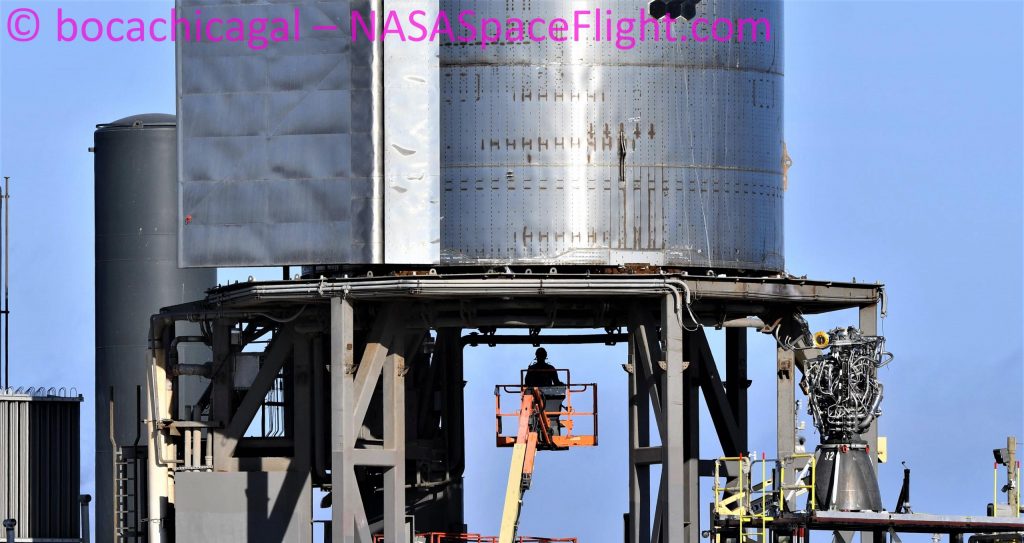

News
SpaceX’s Elon Musk hints at “notable” Starship changes, explains static fire anomaly
CEO Elon Musk has offered an explanation for SpaceX’s recent Starship static fire anomaly and says that an overview of the next-generation rocket development program will be delayed to account for some “notable” design changes.
Over the last several months, Musk has promised to do one of his (thus far) usual annual Starship updates, either in the form of a presentation in South Texas, an article published on SpaceX’s website, or both. Originally expected in September or October, the CEO’s tentative schedules have come and gone several times. Simultaneously, however, SpaceX has been preparing Starship serial number 8 (SN8) for a range of crucial tests and Starship program firsts, recently culminating in a successful cryogenic proof test, multiple wet dress rehearsals (WDRs), nosecone installation, the first triple-Raptor static fire test, engine tests using smaller ‘header’ tanks, and more.
Unfortunately for SN8, the most recent Raptor engine header static fire – drawing propellant from two small internal tanks mainly used for landing burns – did not go according to plan, resulting in some kind of high-temperature fire and severing Starship’s hydraulic systems. For SpaceX test controllers, that meant a total loss of control of most vehicle valves and pressurization systems, essentially putting one of Starship SN8’s header tanks through an unplanned pressure and failsafe test. In the days since, what exactly caused that unfortunate failure has been the subject of a great deal of discussion – discussion that can finally be put to rest with new information from Musk himself.
In a surprise, SpaceX had apparently decided to add a failsafe to Starship SN8’s new nose section, installing what is known as a burst disk – effectively an automatic single-use valve. Once the upper (liquid oxygen) header tank reached dangerous pressures, the force of that pressure broke the seal, allowing the rocket to vent excess pressure and avoid what would have otherwise been a potentially catastrophic explosion.
The cause of that near-miss, according to Elon Musk, was as simple as debris kicked up during the Starship SN8 Raptor engine static fire directly prior. Producing up to 200 metric tons (~450,000 lbf) of thrust and an exhaust stream traveling some 3.3 kilometers per second (2 mi/s, Mach ~10), Musk says that Raptor tore apart a special ceramic coating covering the concrete directly beneath Starship SN8. Likely accelerated to extreme velocities in milliseconds, shards of that coating reportedly “severed [an] avionics cable, causing [a] bad [Raptor engine shutdown].”


Prior to Musk’s comments, SpaceX technicians had already removed on of SN8’s three Raptors – SN32 – on November 14th and replaced it with Raptor SN42 on November 16th, effectively confirming that any damage suffered by Starship’s engine section was easily repairable. It’s unclear how exactly a single severed cable could result in a Raptor engine seemingly dripping molten metal but regardless of the cause, the fix appears to have been a quick one.

In response to the anomaly, Musk says that Starship avionics cables will ultimately be routed inside steel pipes to shield them from debris, while “water-cooled steel pipes” will be added to the launch pad to help limit the damage Raptors can cause. Perhaps as a partial result of SN8’s troubles at the launch pad, Musk says that his Starship blog post will have to wait, as SpaceX “[may be] making some notable changes” to the launch vehicle.
Prior to Starship SN8’s failed November 12th Raptor test, SpaceX was expected to attempt three consecutive static fires before clearing the rocket for an ambitious 15 km (9.5 mi) flight test. One of those static fires had already been completed on November 10th and it’s unclear if SpaceX’s SN8 test plan has remained unchanged or if the static fire counter has been effectively reset. Either way, barring more surprises, there’s still a definite possibility that Starship SN8 will be ready for its launch debut by the end of November and an even better chance that it will launch some time between now and 2021. Stay tuned for updates!

News
Tesla starts showing how FSD will change lives in Europe
Local officials tested the system on narrow country roads and were impressed by FSD’s smooth, human-like driving, with some calling the service a game-changer for everyday life in areas that are far from urban centers.

Tesla has launched Europe’s first public shuttle service using Full Self-Driving (Supervised) in the rural Eifelkreis Bitburg-Prüm region of Germany, demonstrating how the technology can restore independence and mobility for people who struggle with limited transport options.
Local officials tested the system on narrow country roads and were impressed by FSD’s smooth, human-like driving, with some calling the service a game-changer for everyday life in areas that are far from urban centers.
Officials see real impact on rural residents
Arzfeld Mayor Johannes Kuhl and District Administrator Andreas Kruppert personally tested the Tesla shuttle service. This allowed them to see just how well FSD navigated winding lanes and rural roads confidently. Kruppert said, “Autonomous driving sounds like science fiction to many, but we simply see here that it works totally well in rural regions too.” Kuhl, for his part, also noted that FSD “feels like a very experienced driver.”
The pilot complements the area’s “Citizen Bus” program, which provides on-demand rides for elderly residents who can no longer drive themselves. Tesla Europe shared a video of a demonstration of the service, highlighting how FSD gives people their freedom back, even in places where public transport is not as prevalent.
What the Ministry for Economic Affairs and Transport says
Rhineland-Palatinate’s Minister Daniela Schmitt supported the project, praising the collaboration that made this “first of its kind in Europe” possible. As per the ministry, the rural rollout for the service shows FSD’s potential beyond major cities, and it delivers tangible benefits like grocery runs, doctor visits, and social connections for isolated residents.
“Reliable and flexible mobility is especially vital in rural areas. With the launch of a shuttle service using self-driving vehicles (FSD supervised) by Tesla in the Eifelkreis Bitburg-Prüm, an innovative pilot project is now getting underway that complements local community bus services. It is the first project of its kind in Europe.
“The result is a real gain for rural mobility: greater accessibility, more flexibility and tangible benefits for everyday life. A strong signal for innovation, cooperation and future-oriented mobility beyond urban centers,” the ministry wrote in a LinkedIn post.
News
Tesla China quietly posts Robotaxi-related job listing
Tesla China is currently seeking a Low Voltage Electrical Engineer to work on circuit board design for the company’s autonomous vehicles.

Tesla has posted a new job listing in Shanghai explicitly tied to its Robotaxi program, fueling speculation that the company is preparing to launch its dedicated autonomous ride-hailing service in China.
As noted in the listing, Tesla China is currently seeking a Low Voltage Electrical Engineer to work on circuit board design for the company’s autonomous vehicles.
Robotaxi-specific role
The listing, which was shared on social media platform X by industry watcher @tslaming, suggested that Tesla China is looking to fill the role urgently. The job listing itself specifically mentions that the person hired for the role will be working on the Low Voltage Hardware team, which would design the circuit boards that would serve as the nervous system of the Robotaxi.
Key tasks for the role, as indicated in the job listing, include collaboration with PCB layout, firmware, mechanical, program management, and validation teams, among other responsibilities. The role is based in Shanghai.
China Robotaxi launch
China represents a massive potential market for robotaxis, with its dense urban centers and supportive policies in select cities. Tesla has limited permission to roll out FSD in the country, though despite this, its vehicles have been hailed as among the best in the market when it comes to autonomous features. So far, at least, it appears that China supports Tesla’s FSD and Robotaxi rollout.
This was hinted at in November, when Tesla brought the Cybercab to the 8th China International Import Expo (CIIE) in Shanghai, marking the first time that the autonomous two-seater was brought to the Asia-Pacific region. The vehicle, despite not having a release date in China, received a significant amount of interest among the event’s attendees.
Elon Musk
Elon Musk and Tesla AI Director share insights after empty driver seat Robotaxi rides
The executives’ unoccupied tests hint at the rapid progress of Tesla’s unsupervised Robotaxi efforts.

Tesla CEO Elon Musk and AI Director Ashok Elluswamy celebrated Christmas Eve by sharing personal experiences with Robotaxi vehicles that had no safety monitor or occupant in the driver’s seat. Musk described the system’s “perfect driving” around Austin, while Elluswamy posted video from the back seat, calling it “an amazing experience.”
The executives’ unoccupied tests hint at the rapid progress of Tesla’s unsupervised Robotaxi efforts.
Elon and Ashok’s firsthand Robotaxi insights
Prior to Musk and the Tesla AI Director’s posts, sightings of unmanned Teslas navigating public roads were widely shared on social media. One such vehicle was spotted in Austin, Texas, which Elon Musk acknowleged by stating that “Testing is underway with no occupants in the car.”
Based on his Christmas Eve post, Musk seemed to have tested an unmanned Tesla himself. “A Tesla with no safety monitor in the car and me sitting in the passenger seat took me all around Austin on Sunday with perfect driving,” Musk wrote in his post.
Elluswamy responded with a 2-minute video showing himself in the rear of an unmanned Tesla. The video featured the vehicle’s empty front seats, as well as its smooth handling through real-world traffic. He captioned his video with the words, “It’s an amazing experience!”
Towards Unsupervised operations
During an xAI Hackathon earlier this month, Elon Musk mentioned that Tesla owed be removing Safety Monitors from its Robotaxis in Austin in just three weeks. “Unsupervised is pretty much solved at this point. So there will be Tesla Robotaxis operating in Austin with no one in them. Not even anyone in the passenger seat in about three weeks,” he said. Musk echoed similar estimates at the 2025 Annual Shareholder Meeting and the Q3 2025 earnings call.
Considering the insights that were posted Musk and Elluswamy, it does appear that Tesla is working hard towards operating its Robotaxis with no safety monitors. This is quite impressive considering that the service was launched just earlier this year.








